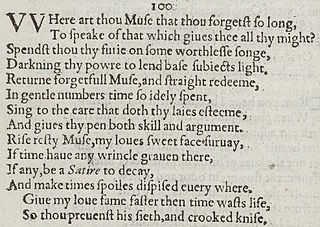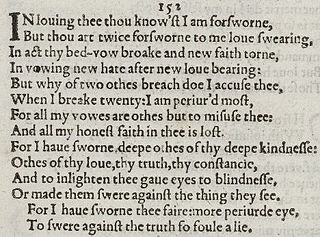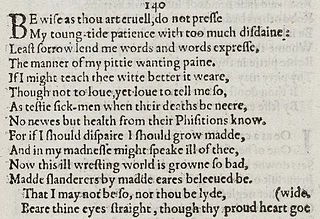| Sonnet 143 | |||||||
|---|---|---|---|---|---|---|---|
 Sonnet 143 in the 1609 Quarto | |||||||
| | |||||||
| |||||||
Sonnet 143 is one of 154 sonnets written by the English playwright and poet William Shakespeare.
| Sonnet 143 | |||||||
|---|---|---|---|---|---|---|---|
 Sonnet 143 in the 1609 Quarto | |||||||
| | |||||||
| |||||||
Sonnet 143 is one of 154 sonnets written by the English playwright and poet William Shakespeare.
Sonnet 143 is an English or Shakespearean sonnet. The English sonnet has three quatrains, followed by a final rhyming couplet. It follows the typical rhyme scheme of the form ABAB CDCD EFEF GG and is composed in iambic pentameter, a type of poetic metre based on five pairs of metrically weak/strong syllabic positions. The 7th line exemplifies a regular iambic pentameter:
× / × / × / × / × / To follow that which flies before her face, (143.7)
Line 2 begins with a common metrical variation, an initial reversal:
/ × × / × / × / × / One of her feather'd creatures broke away, (143.2)
Initial reversals occur in lines 2 and 6, and potentially in lines 1, 3, 5, and 13. Several phrases which might imply a metrical variant in other contexts are rendered doubtful in this poem because of the frequency with which contrastive accent on pronouns is suggested by both the nature of the story and the meter. For example, line 5 is capable of both an initial and a mid-line reversal:
/ × × / × / / × × / Whilst her neglected child holds her in chase, (143.5)
However, the story's emphasis on pronouns may render a regular reading more likely:
× / × / × / × / × / Whilst her neglected child holds her in chase, (143.5)
Similarly line 12's "kiss me" — which in most contexts would reverse the ictus to the tonic stress of "kiss" — might here retain a regular rhythm by implying contrastive accent on "me". Lines 8 and 12 may also suggest accentuated pronouns which maintain a regular rhythm.
The meter demands line 4's "pursuit" be stressed on the first syllable. [2]

Sonnet 51 is one of 154 sonnets written by the English playwright and poet William Shakespeare. It is part of the Fair Youth sequence, in which the poet expresses his love towards a young man. It is a continuation of the argument from Sonnet 50.

Sonnet 100 is one of 154 sonnets written by the English playwright and poet William Shakespeare. It is a member of the Fair Youth sequence, in which the poet expresses his love towards a young man.

Sonnet 63 is one of 154 sonnets published in 1609 by the English playwright and poet William Shakespeare. It is one of the Fair Youth sequence. Contrary to most of the other poems in the Fair Youth sequence, in Sonnets 63 to 68 there is no explicit addressee, and the second person pronoun is not used anywhere in sonnets 63 to 68.

Sonnet 68 is one of 154 sonnets written by the English playwright and poet William Shakespeare. It is a member of the Fair Youth sequence, in which the poet expresses his love towards a young man.
Sonnet 132 is one of 154 sonnets written by the English playwright and poet William Shakespeare.

Sonnet 134 is one of 154 sonnets written by the English poet and playwright William Shakespeare. In it, the speaker confronts the Dark Lady after learning that she has seduced the Fair Youth.

Sonnet 152 is a sonnet by William Shakespeare. It is one of a collection of 154 sonnets, dealing with themes such as the passage of time, love, beauty and mortality, first published in a 1609.

Sonnet 150 is one of 154 sonnets written by the English playwright and poet William Shakespeare. It is considered a Dark Lady sonnet, as are all from 127 to 152. Nonetheless 150 is an outlier, and in some ways appears to belong more to the Fair Youth.
Sonnet 149 is one of 154 sonnets written by the English playwright and poet William Shakespeare.

Sonnet 148 is one of 154 sonnets written by the English playwright and poet William Shakespeare.

Sonnet 107 is one of 154 sonnets written by the English playwright and poet William Shakespeare. It is a member of the Fair Youth sequence, in which the poet expresses his love towards a young man.

Sonnet 142 is one of 154 sonnets written by the English playwright and poet William Shakespeare.

Sonnet 140 is one of 154 sonnets written by the English playwright and poet William Shakespeare. Sonnet 140 is one of the Dark Lady sonnets, in which the poet writes to a mysterious woman who rivals the Fair Youth for the poet's affection.

Sonnet 139 is one of 154 sonnets written by the English playwright and poet William Shakespeare.
Sonnet 137 is one of 154 sonnets written by the English playwright and poet William Shakespeare.

Sonnet 90 is one of 154 sonnets written by the English playwright and poet William Shakespeare. It is a member of the Fair Youth sequence, in which the poet expresses his love towards a young man.

Sonnet 95 is one of 154 sonnets written by the English playwright and poet William Shakespeare. It is a member of the Fair Youth sequence, in which the poet expresses his love towards a young man.

Sonnet 114 is one of 154 sonnets written by the English playwright and poet William Shakespeare. It is a member of the Fair Youth sequence, in which the poet expresses his love towards a young man.

Shakespeare's sonnet 117 was first published in 1609. It uses similar imagery to Sonnet 116 and expands on the challenge in the closing couplet. Using legally resonant metaphors, the poet defends himself against accusations of ingratitude and infidelity by saying that he was merely testing the constancy of those same things in his friend.

Sonnet 122 is one of 154 sonnets written by the English playwright and poet William Shakespeare, and first published in 1609. It is a member of the Fair Youth sequence, in which the poet expresses his love towards a young man. Although the relationship started exuberantly in Sonnet 18 by now it has given way to an almost defensive tone. The poet justifies giving away or losing a notebook ("tables") given him by the youth to record shared events by saying that his memories of them are stronger.